Zabihah and Halal both follow Islamic dietary laws but focus on different aspects. Zabihah refers specifically to the proper Islamic method of slaughter, often requiring a qualified slaughterer and invocation of Allah’s name. Halal covers a broader range of dietary rules, including ingredients and handling, with certification practices that vary by region. Understanding these differences can help you make more informed choices, and there’s much more to explore on how these standards impact your food.
Key Takeaways
- Zabihah refers specifically to the Islamic slaughter method, while Halal encompasses broader dietary and ingredient guidelines.
- Zabihah emphasizes strict adherence to religious slaughter techniques, including invocation of Allah’s name, whereas Halal certification may vary regionally.
- Zabihah standards are typically more precise and stricter, focusing on the slaughter process itself; Halal covers additional aspects like ingredients and handling.
- Certification for Zabihah often requires specific slaughterer qualifications and direct religious invocation, while Halal certifications may have broader oversight.
- Both ensure meat is permissible in Islam, but Zabihah centers on religious slaughter, whereas Halal also emphasizes overall food purity and ethical practices.
Origins and Historical Background

The origins of Zabihah and Halal practices trace back to ancient Islamic traditions, where dietary rules were established to guarantee that meat consumption aligns with religious principles. These traditional practices date to early Islamic history, reflecting a desire to follow divine commandments. These practices emphasize the importance of proper slaughter methods, ensuring animals are treated with respect and sacrificed in a humane way. Over time, these practices became deeply embedded in Muslim communities, shaping cultural and religious identity. Zabihah, specifically, refers to the method of slaughter prescribed by Islamic law, which is a core aspect of Halal standards. Understanding these roots helps you appreciate how these practices have preserved their religious significance across generations. Additionally, the significance of cultural and artistic influence underscores how traditional practices often extend beyond dietary rules, embodying broader cultural values and artistic expressions. Recognizing the religious significance of these practices reveals their role in reinforcing community bonds and spiritual adherence. Moreover, the consistent adherence to these methods highlights their importance in maintaining religious authenticity within Muslim communities.
Definitions and Core Principles
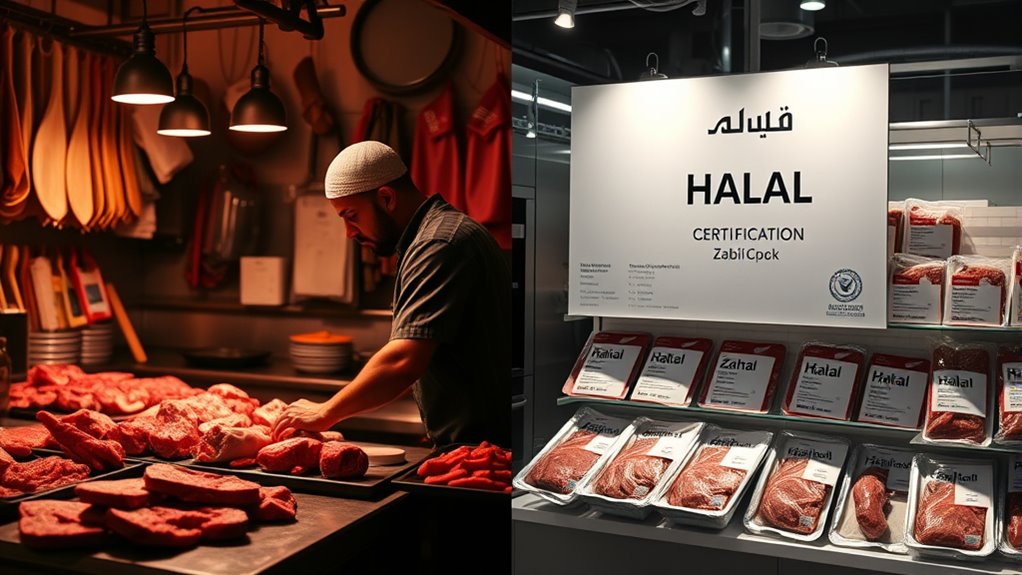
Understanding the core principles of Zabihah and Halal involves recognizing their focus on humane slaughter methods and adherence to religious guidelines. Both emphasize animal welfare, ensuring animals are treated ethically before slaughter. They also respect dietary restrictions outlined in Islamic law, making the meat permissible for Muslims. Although similar, their definitions differ slightly. Zabihah strictly refers to the method of slaughter prescribed by Islamic law, while Halal encompasses a broader range of dietary rules, including what is permissible beyond slaughter. Visualize these principles as follows:
| Principle | Focus | Outcome |
|---|---|---|
| Animal Welfare | Humane treatment | Ethical slaughter |
| Religious Guidelines | Following Islamic law | Permissible foods |
| Dietary Restrictions | Allowed and forbidden foods | Faith-based diet compliance |
Additionally, slaughter techniques are integral to maintaining compliance with both standards and ensuring the meat’s acceptability. Proper slaughter procedures are essential to uphold the integrity and authenticity of both Zabihah and Halal practices, reinforcing their emphasis on ethical treatment and religious adherence.
Methods of Animal Slaughter
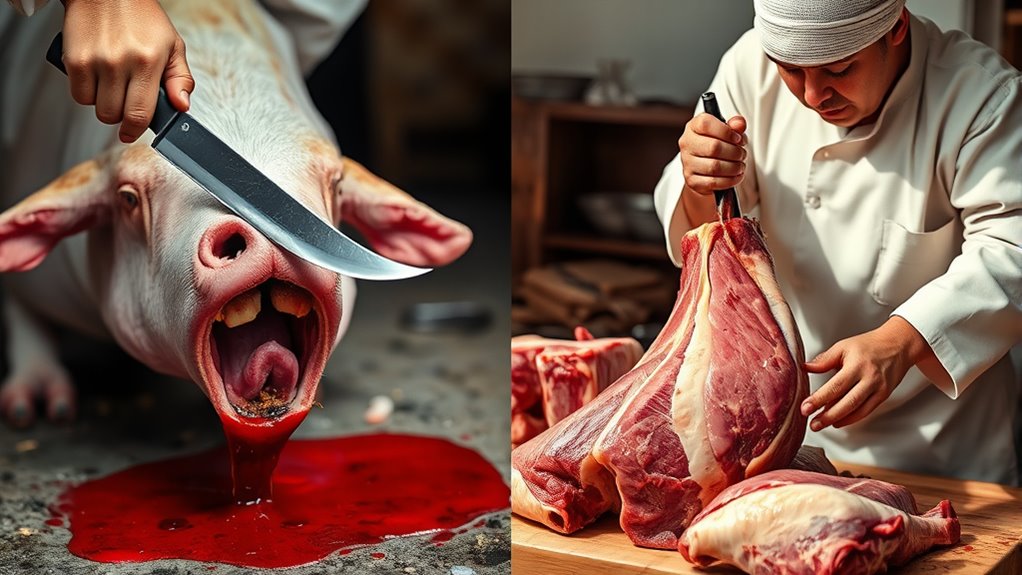
Methods of animal slaughter are central to guaranteeing that meat meets religious and ethical standards. The slaughtering techniques used must align with religious requirements, such as ensuring the animal is alive and healthy at the moment of slaughter. In Islamic practices, this involves a swift, humane cut to the throat, severing major blood vessels while invoking a prayer. Similarly, halal slaughter emphasizes minimizing pain and stress, often through specific methods approved by religious authorities. Zabihah, a term used in Islamic slaughter, strictly follows these techniques to meet religious standards. These methods aim to confirm the meat is pure and permissible, respecting both ethical considerations and religious commandments. Proper slaughtering techniques are essential to produce meat that adheres to these core principles, and religious compliance ensures that the process remains consistent with faith-based guidelines.
Certification Processes and Authorities
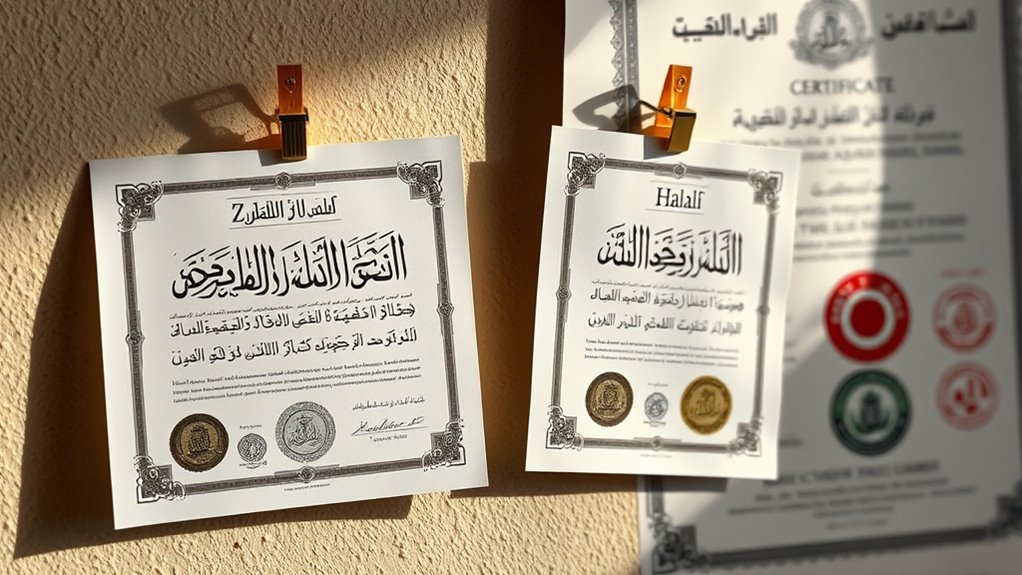
Certification processes and authorities play a crucial role in guaranteeing that meat labeled as Zabihah or halal meets strict religious and ethical standards. Certification authorities are responsible for verifying that slaughter practices comply with religious guidelines and uphold ethical treatment of animals. These authorities oversee certification processes, which involve auditing slaughterhouses, reviewing procedures, and ensuring proper recording and documentation. When you see halal or Zabihah labels, it’s backed by these certifying bodies that confirm adherence to religious laws. These certification processes may vary by region or community but always aim to guarantee the meat’s authenticity and purity. By working with recognized certification authorities, producers ensure their products meet the necessary standards, giving consumers confidence in the meat’s religious compliance. Additionally, slaughter practices are closely monitored to ensure they align with both religious and humane standards, reinforcing trust in certified products. Proper certification procedures are essential to maintain consistent quality and trustworthiness across different markets, and ongoing oversight helps prevent mislabeling or fraud in the industry. Furthermore, establishing transparent and standardized certification processes helps build consumer trust and supports industry integrity.
Cultural Significance and Usage
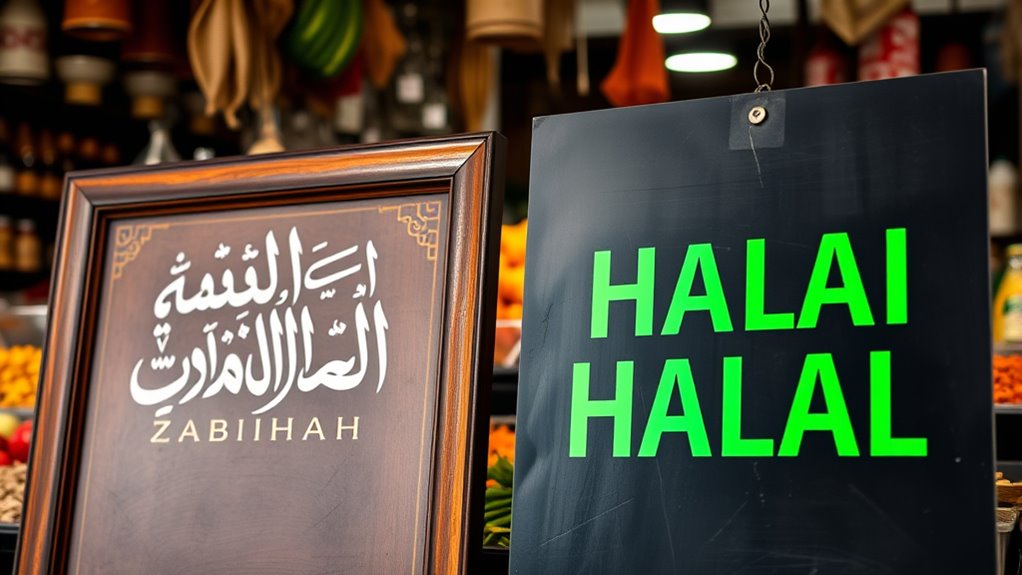
Cultural significance deeply influences how Zabihah and halal meat are perceived and used within various communities. These practices embody cultural symbolism and reinforce regional identity, shaping rituals and social bonds. Understanding this helps you see that:
- In some communities, Zabihah is a symbol of religious adherence and cultural pride.
- Halal practices may reflect broader regional traditions, blending religious and cultural elements.
- Food preparation methods often carry cultural symbolism, emphasizing purity and spirituality, especially when aligned with specific rituals and customs.
- Consumption patterns reinforce regional identity, connecting individuals to their heritage and shared values.
- The cultural symbolism associated with these practices often guides community norms and individual choices regarding meat consumption.
- Additionally, the way these practices are integrated into dining and living spaces can further emphasize their cultural importance.
- Recognizing these cultural influences enhances appreciation of the diverse ways communities express their faith through food and lifestyle choices.
- The importance of WWE Raw’s financial impact demonstrates how entertainment practices can also serve as a form of cultural expression and community bonding.
Geographic Variations and Regional Practices
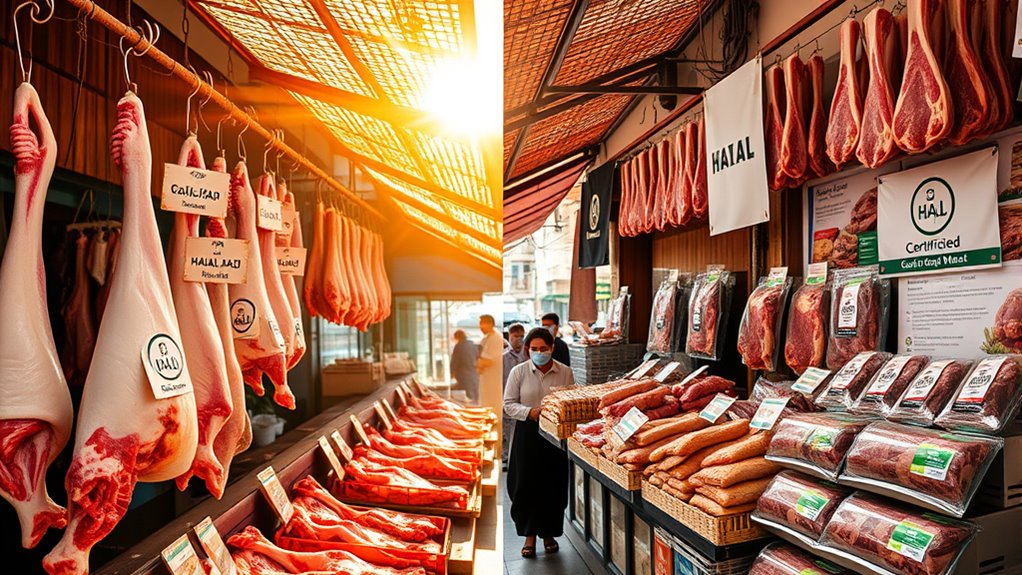
You’ll notice that halal practices vary widely depending on where you are, shaped by regional standards and local culinary traditions. These differences influence how meat is prepared and what certifications are recognized in each area. Understanding these regional practices helps you appreciate the diversity within halal food around the world. Additionally, farmhouse bedroom design principles highlight the importance of regional influences in creating authentic and cozy spaces, much like regional variations in halal practices shape diverse culinary traditions. Recognizing regional standards in halal certification ensures compliance with local customs and enhances trust among consumers. Moreover, regional culinary traditions often dictate specific ingredients and preparation methods that are integral to traditional halal dishes, and these traditions are often preserved through sound design techniques that emphasize authenticity and cultural identity. This regional variation can also be linked to differences in sustainable practices, which influence how halal food is produced and consumed across different areas.
Regional Halal Standards
Regional halal standards vary markedly across different geographic areas, reflecting local traditions, legal frameworks, and cultural practices. These regional variations influence how halal is understood and practiced, often shaped by culinary influences unique to each region. For example:
- Local interpretations of slaughter methods
- Variations in certification processes
- Differences in permissible ingredients
- Cultural preferences impacting halal practices
Additionally, ethical considerations play a significant role in shaping regional standards, ensuring practices align with both religious requirements and societal expectations. The regulatory environment further influences how these standards are implemented and enforced across different regions.
Local Culinary Traditions
Local culinary traditions shape how halal practices are interpreted and implemented across different regions. You’ll notice that culinary fusion influences regional dishes, blending local ingredients and cooking methods with halal standards. These traditions create unique flavor profiles that reflect geographic and cultural influences, from spicy South Asian curries to savory Middle Eastern kebabs. In some areas, spices and herbs are used liberally, enhancing taste without compromising halal requirements. Regional practices also determine the types of meat and preparation techniques, affecting how halal is observed locally. Additionally, understanding regional flavor profiles helps to appreciate how traditional dishes adapt within halal guidelines, celebrating regional identities while maintaining religious principles. The presence of diverse cooking techniques across regions further exemplifies how tradition and religious standards harmonize to produce authentic halal cuisine. This diversity enriches the global halal culinary landscape, making it a vibrant tapestry of flavors. By understanding local traditions, you gain insight into how traditional dishes adapt within halal guidelines, celebrating regional identities while maintaining religious principles.
Common Misconceptions and Clarifications

Many people believe that all halal certifications are the same, but in reality, standards vary widely. You might also think Zabihah always meets religious requirements, yet some practices differ regionally. It’s important to understand the difference between cultural traditions and religious laws to avoid misconceptions.
Halal Certification Myths
There are several misconceptions about halal certification that can lead to confusion and mistrust. One common myth is that certification authenticity is always guaranteed, but standards can vary due to cultural influence. To clarify:
- Not all certifications are equally strict; some may lack proper oversight.
- Cultural influence can shape certification practices, affecting their consistency.
- Some believe that halal certification is just a formality, but it ensures proper slaughter and handling.
- Many assume all halal labels are the same, ignoring regional or organizational differences.
Understanding these myths helps you recognize that genuine halal certification prioritizes authenticity and reflects diverse cultural practices. This awareness ensures you’re making informed choices based on credible certification rather than misconceptions.
Zabihah Vs Halal Standards
When comparing Zabihah standards to general halal standards, it’s important to recognize that misconceptions often lead to confusion about their differences. Zabihah emphasizes strict adherence to religious ethics and animal welfare, ensuring the slaughter process aligns with Islamic principles. While both standards aim to produce permissible meat, Zabihah often requires specific slaughterer qualifications and a direct invocation of Allah’s name. Some believe all halal meat is Zabihah, but this isn’t always true. Here’s a quick comparison:
| Aspect | Zabihah | General Halal |
|---|---|---|
| Religious ethics | Strict adherence, direct prayer | Varies, may lack specific rituals |
| Animal welfare | Emphasizes humane slaughter | Varies, less standardized |
| Certification | Often stricter, specific | Broader, sometimes less precise |
Cultural Vs Religious Practices
Cultural practices often influence how halal meat is prepared and consumed, but these customs can sometimes lead to misconceptions about their alignment with religious requirements. It’s important to distinguish between cultural rituals and religious obligations to avoid confusion. Here are four key points:
- Cultural rituals vary across regions but don’t alter the core religious principles of halal.
- Religious obligations, like the method of slaughter, are universal for halal, regardless of cultural differences.
- Some practices, such as specific prayers or rituals, are cultural additions, not mandatory religious requirements.
- Recognizing these differences helps you understand that cultural customs enhance tradition but don’t redefine religious standards.
Impact on Food Quality and Taste

The way Zabihah and Halal certification standards are applied can substantially influence the quality and taste of food. When strict adherence to these standards is maintained, the food flavor remains authentic and appealing. High ingredient quality is essential, as it directly affects the overall taste and texture of dishes. Proper slaughtering practices ensure that meat retains its natural juiciness and flavor, enhancing the eating experience. Additionally, the use of fresh, quality ingredients without additives or preservatives preserves the food’s natural taste. If certification processes are rigorous, they prevent contamination and ensure consistency, resulting in better food quality. Ultimately, these standards shape the flavor profile and ingredient integrity, influencing your satisfaction with the food you consume.
Availability and Accessibility in Markets

You’ll notice that Zabihah and halal products aren’t always equally available in markets. In some regions, one type might dominate certain stores, while others are harder to find. This variation affects how easily you can access these foods in your local shops.
Market Presence Differences
While Zabihah and Halal products both serve the Muslim community, their availability varies markedly across markets. Your access depends on factors like:
- Market share—Zabihah often dominates in regions with a strong online presence, influencing consumer choices.
- Consumer preferences—In areas where traditional methods are valued, Halal-certified products may have higher demand.
- Distribution channels—Zabihah’s reliance on digital platforms can limit physical store availability, unlike more widespread Halal brands.
- Regulatory environments—Markets with strict Halal certification laws tend to favor officially certified products, affecting market presence.
Understanding these differences helps you navigate your options based on what’s accessible and aligned with your preferences.
Geographic Availability Variations
Geographic availability of Zabihah and Halal products varies considerably across different regions, shaping how easily you can access them. Regional compliance plays a key role in determining market penetration, influencing whether these products are widely available or limited to niche markets. In areas with strong religious or cultural communities, you’ll find higher concentrations of Zabihah and Halal options due to stricter adherence to regional standards. Conversely, regions with less demand or unclear regulations may have limited offerings. This variation affects your shopping experience, as some markets prioritize certain certifications to meet local expectations. Understanding regional compliance helps you navigate where to find authentic Zabihah or Halal products, ensuring you get what aligns with your preferences and religious requirements.
Accessibility in Local Stores
Access to Zabihah and Halal products in local stores varies widely, often depending on the store’s location and customer base. This affects your shopping convenience and the ease of finding authentic options. To improve local store accessibility, consider these factors:
- Density of Halal markets in your area
- Store size and product variety
- Availability of specialized Zabihah or Halal sections
- Community demand influencing store stock choices
These elements determine how easily you can access authentic products during your shopping trips. A store with a dedicated Halal or Zabihah section offers more convenience and confidence in product authenticity. Recognizing these factors helps you find the right stores that meet your dietary needs with greater ease and efficiency.
Choosing Between Zabihah and Halal Products

When choosing between Zabihah and Halal products, understanding the key differences can help you make an informed decision. Look for clear Halal labeling to verify that the product meets Islamic dietary standards. Zabihah products often follow specific religious authority guidelines, which can vary depending on the certifying body. If you prefer a stricter or more recognized certification, check which religious authority endorses the product. Some labels emphasize authentic Zabihah methods, while others highlight broader Halal standards. Your choice depends on your trust in the certifying organization and your personal interpretation of Halal requirements. By paying attention to Halal labeling and understanding the religious authority behind it, you ensure the meat aligns with your beliefs and standards.
Frequently Asked Questions
Are Zabihah and Halal Practices Legally Recognized Worldwide?
You wonder if zabihah and halal practices are legally recognized worldwide. The answer depends on the country, as religious legitimacy and cultural acceptance vary globally. Some nations formally acknowledge halal certification, while others do not regulate it, leaving recognition up to local authorities or communities. Zabihah practices, being a specific method within halal, often share similar legal status, but worldwide acceptance hinges on local laws, religious bodies, and cultural norms.
How Do Consumer Perceptions Differ Between Zabihah and Halal Foods?
You might notice that consumer trust and quality perceptions often influence how you view zabihah and halal foods. Many see zabihah as more authentic or strictly religious, boosting trust in its purity. Halal, however, is sometimes viewed as more accessible or regulated, which can affect quality perceptions. Your personal experience and cultural background shape whether you perceive one as more trustworthy or higher quality than the other.
Can Non-Muslims Consume Zabihah or Halal Products Safely?
You can safely consume zabihah or halal products if you understand their cultural significance and respect dietary restrictions. Many non-Muslims do so, especially when the food aligns with their preferences or ethical choices. Cultural acceptance varies, but generally, these foods are safe if prepared properly. Just confirm the products meet your personal standards, and be aware of any ingredients or practices that might conflict with your dietary needs or beliefs.
Are There Differences in Environmental Impact Between the Methods?
You might wonder if there are environmental differences between these methods. Typically, halal and zabihah practices can promote sustainable farming and water conservation, as they often emphasize humane treatment and responsible resource use. However, the environmental impact depends on specific farming techniques and supply chain practices. By choosing products that prioritize eco-friendly farming and water conservation, you contribute to reducing environmental harm, regardless of the certification type.
How Do Certification Standards Vary Across Different Countries?
Think of certification standards as a patchwork quilt—each piece reflecting its country’s cultural influences. You’ll find that certification processes vary widely across nations, shaped by local religious practices and legal systems. Some countries have strict, centralized standards, while others rely on community-based approvals. This diversity means that what’s certified as halal or zabihah in one place might differ elsewhere, highlighting the rich tapestry of cultural influences that shape these standards worldwide.
Conclusion
Understanding zabihah and halal helps you make informed choices, appreciate cultural traditions, and guarantee ethical practices. Recognizing their differences clarifies your options, enhances your confidence in food selection, and deepens your respect for religious principles. Whether you prioritize certification, methods, or cultural significance, knowing these distinctions empowers you to choose wisely, to support ethical practices, and to enjoy your food with confidence. Ultimately, informed choices lead to respectful consumption and a richer culinary experience.









